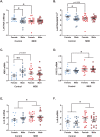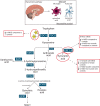Sex- and suicide-specific alterations in the kynurenine pathway in the anterior cingulate cortex in major depression
- PMID: 37735504
- PMCID: PMC10789861
- DOI: 10.1038/s41386-023-01736-8
Sex- and suicide-specific alterations in the kynurenine pathway in the anterior cingulate cortex in major depression
Abstract
Major depressive disorder (MDD) is a serious psychiatric disorder that in extreme cases can lead to suicide. Evidence suggests that alterations in the kynurenine pathway (KP) contribute to the pathology of MDD. Activation of the KP leads to the formation of neuroactive metabolites, including kynurenic acid (KYNA) and quinolinic acid (QUIN). To test for changes in the KP, postmortem anterior cingulate cortex (ACC) was obtained from the National Institute of Health NeuroBioBank. Gene expression of KP enzymes and relevant neuroinflammatory markers were investigated via RT-qPCR (Fluidigm) and KP metabolites were measured using liquid chromatography-mass spectrometry in tissue from individuals with MDD (n = 44) and matched nonpsychiatric controls (n = 36). We report increased IL6 and IL1B mRNA in MDD. Subgroup analysis found that female MDD subjects had significantly decreased KYNA and a trend decrease in the KYNA/QUIN ratio compared to female controls. In addition, MDD subjects that died by suicide had significantly decreased KYNA in comparison to controls and MDD subjects that did not die by suicide, while subjects that did not die by suicide had increased KYAT2 mRNA, which we hypothesise may protect against a decrease in KYNA. Overall, we found sex- and suicide-specific alterations in the KP in the ACC in MDD. This is the first molecular evidence in the brain of subgroup specific changes in the KP in MDD, which not only suggests that treatments aimed at upregulation of the KYNA arm in the brain may be favourable for female MDD sufferers but also might assist managing suicidal behaviour.
© 2023. The Author(s).
Conflict of interest statement
CSW collaborates with Astellas Pharma Inc., Japan. All other authors declare no competing interests.
Figures




Similar articles
-
Relationship between neurotoxic kynurenine metabolites and reductions in right medial prefrontal cortical thickness in major depressive disorder.Brain Behav Immun. 2016 Mar;53:39-48. doi: 10.1016/j.bbi.2015.11.003. Epub 2015 Nov 4. Brain Behav Immun. 2016. PMID: 26546831 Free PMC article.
-
Altered tryptophan catabolite concentrations in major depressive disorder and associated changes in hippocampal subfield volumes.Psychoneuroendocrinology. 2018 Sep;95:8-17. doi: 10.1016/j.psyneuen.2018.05.019. Epub 2018 May 19. Psychoneuroendocrinology. 2018. PMID: 29787958
-
Peripheral and central kynurenine pathway abnormalities in major depression.Brain Behav Immun. 2022 Mar;101:136-145. doi: 10.1016/j.bbi.2022.01.002. Epub 2022 Jan 6. Brain Behav Immun. 2022. PMID: 34999196 Free PMC article.
-
Dynamic changes in kynurenine pathway metabolites in multiple sclerosis: A systematic review.Front Immunol. 2022 Nov 2;13:1013784. doi: 10.3389/fimmu.2022.1013784. eCollection 2022. Front Immunol. 2022. PMID: 36426364 Free PMC article.
-
Neurobiological mechanisms in the kynurenine pathway and major depressive disorder.Rev Neurosci. 2024 Sep 9;36(2):169-187. doi: 10.1515/revneuro-2024-0065. Print 2025 Feb 25. Rev Neurosci. 2024. PMID: 39245854 Review.
Cited by
-
Parkinson's disease is characterized by vitamin B6-dependent inflammatory kynurenine pathway dysfunction.Res Sq [Preprint]. 2024 Sep 26:rs.3.rs-4980210. doi: 10.21203/rs.3.rs-4980210/v1. Res Sq. 2024. Update in: NPJ Parkinsons Dis. 2025 Apr 26;11(1):96. doi: 10.1038/s41531-025-00964-7. PMID: 39399688 Free PMC article. Updated. Preprint.
-
Sex Differences in Depression: Insights from Multimodal Gray Matter Morphology and Peripheral Inflammatory Factors.Int J Mol Sci. 2024 Dec 14;25(24):13412. doi: 10.3390/ijms252413412. Int J Mol Sci. 2024. PMID: 39769178 Free PMC article.
-
Serum neurotransmitter analysis of motor and non-motor symptoms in Parkinson's patients.Front Aging Neurosci. 2024 Nov 25;16:1423120. doi: 10.3389/fnagi.2024.1423120. eCollection 2024. Front Aging Neurosci. 2024. PMID: 39654806 Free PMC article.
-
The impact of BDNF and CD4 + T cell crosstalk on depression.Immunol Res. 2024 Oct;72(5):883-894. doi: 10.1007/s12026-024-09514-4. Epub 2024 Jul 9. Immunol Res. 2024. PMID: 38980567 No abstract available.
-
Changes in tryptophan breakdown associated with response to multimodal treatment in depression.Front Psychiatry. 2024 Jun 21;15:1380620. doi: 10.3389/fpsyt.2024.1380620. eCollection 2024. Front Psychiatry. 2024. PMID: 38974918 Free PMC article.
References
-
- Andrade L, Caraveo‐anduaga JJ, Berglund P, Bijl RV, Graaf RD, Vollebergh W, et al. The epidemiology of major depressive episodes: results from the International Consortium of Psychiatric Epidemiology (ICPE) surveys. Int J Methods Psychiatr Res. 2006;12:3–21. doi: 10.1002/mpr.138. - DOI - PMC - PubMed
MeSH terms
Substances
LinkOut - more resources
Full Text Sources
Medical

